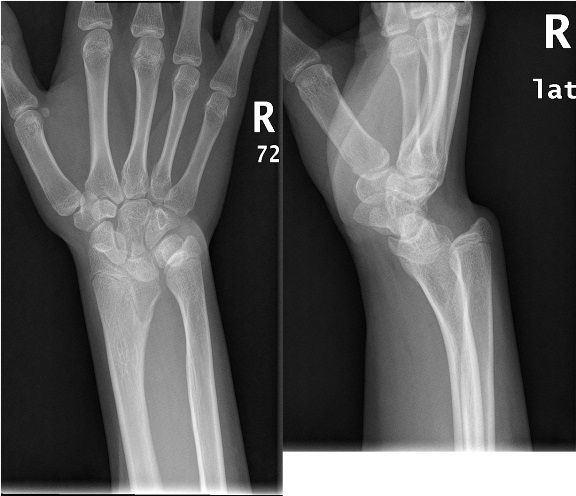- AI
- Molecular Imaging
- CT
- X-Ray
- Ultrasound
- MRI
- Facility Management
- Mammography
Madelung’s Deformity
A 12-year-old girl with bilateral wrist deformity, characterized by growth disturbance in the volar ulnar distal radial physis resulting in volar and ulnar tilted distal radial articular surface, volar translation of the hand and wrist and dorsally prominent distal ulna.
Clinical History: A 12-year-old girl with bilateral wrist deformity

Bilateral wrist X-ray findings:
Bilateral Madelung’s deformity characterized by growth disturbance in the volar ulnar distal radial physis resulting in volar and ulnar tilted distal radial articular surface, volar translation of the hand and wrist and dorsally prominent distal ulna. The carpal bone otherwise is unremarkable. Visualized metacarpal is unremarkable.

Madelung’s Deformity:
Arrest of epiphyseal growth of the ulnar (medial) and volar (anterior) portions of the distal radius, it leads to shortening of the radius and relative overgrowth of the ulna. The deformity is inherited as an autosomal dominant due to mutation on X chromosome and has variable penetrance. It overwhelmingly occurs in females. It is a rare congenital deformity that does not usually manifest until ages 10 to 14. It may also be seen as an acquired consequence of trauma to the growth plate (e.g. Salter V fracture).
Clinical findings include onset of pain in one wrist and then the other; prominence of the distal ulnar head posteriorly; and limitation of motion, especially extension and supination.
Etiology:
Henry and Thorburn classified MD into four different etiologic groups: (1) posttraumatic, (2) dysplastic, (3) chromosomal or genetic (Turner syndrome), and (4) idiopathic or primary. The posttraumatic deformity has been found following repetitive trauma or following a single event that disrupts growth of the distal radial ulnar-volar physis. Bone dysplasias associated with MD include multiple hereditary osteochondromatosis, Ollier disease, achondroplasia, multiple epiphysial dysplasias, and the mucopolysaccharidoses (e.g., Hurler and Morquio syndromes). Secondary causes of wrist deformity that may mimic MD include sickle-cell disease, infection, tumor, and rickets. The most important dysplasia associated with MD, however, is dyschondrosteosis.
Pathophysiology:
One third of cases of MD are transmitted in an autosomal dominant fashion. The condition has a variable expression and 50 percent penetrance. MD is bilateral in 50 percent of cases and is primarily found in females. Numerous cases of multiple patients with MD within families have been reported. A recent report details five generations of family members with bilateral MD without signs of dyschondrosteosis. Finally, a primary chromosomal association with MD has been observed in patients with Turner syndrome (karyotype XO). MD was the presenting sign of Turner syndrome in one young girl, while Henry and Thorburn diagnosed Turner syndrome incidentally when studying a series of patients with MD who underwent cytogenetic evaluation
Imaging Findings:
Bilateral in 50 percent to 66 percent of patients
Exaggerated radial inclination
“V-shaped” proximal carpal row
Dorsal dislocation of the ulnar head.
Differential Diagnosis:
Madelung's dyschondrosteosis
Form of mesomelic dwarfism, especially if condition is bilateral or there is a family history of short stature
Short forearms
Short tibia/fibula
Treatment:
Deformity will progress until distal radial epiphysis closes. Conservative management if asymptomatic, and operative correction for relief of pain and cosmetic improvement.
Relevant Anatomy:
An important anatomical consideration in MD is the normal position of the distal radial articular surface. Four features of this articular surface should be noticed radiographically, namely, radial inclination, radial length, volar tilt, and ulnar variance. Radial inclination is the angle formed by a line from the distal radioulnar joint to the radial styloid and a line perpendicular to the shaft of the radius through the lunate fossa. The angle normally is 21 23 degrees. Radial length is the difference in longitudinal level between the lunate fossa and the radial styloid, which should be 12 to 15 mm. Volar tilt is measured on a lateral radiograph and is the angle formed between a line perpendicular to the radial shaft and a line through the dorsal and volar rims of the radial joint surface. Normally, this is 10 to 15 degrees. Finally, ulnar variance is the relative difference in height between the radial and ulnar distal articular surfaces. These should be level with each other.
Sushila Ladumor, MD, FRCR, consultant radiologist with multi-modality imaging experience, working in Medical Imaging Department, King Abdulaziz Medical City, Riyadh, Saudi Arabia.
References:
http://emedicine.medscape.com/article/1260002-overview#a05
Anton JI, Reitz GB, Speigel MB. Madelung's deformity. Ann Surg. 1938;108(3):411-39.
Nielsen JB. Madelung's deformity. A follow-up study of 26 cases and a review of the literature. Acta Orthop Scand. 1977;48(4):379-84. [Medline].
http://www.learningradiology.com/archives2009/COW%20350-Madelungs/madelungscorrect.htm
Emerging Perspectives on PSMA PET Radiotracers: An Interview with Kenneth J. Pienta, MD
April 24th 2024In a recent interview, Kenneth J. Pienta, M.D., discussed the impact of piflufolastat F18, current directions in research with other PSMA-targeted radiotracers and future possibilities for the role of PSMA PET in the imaging paradigm for prostate cancer.
Study Reveals Benefits of Photon-Counting CT for Assessing Acute Pulmonary Embolism
April 23rd 2024In comparison to energy-integrating detector CT for the workup of suspected acute pulmonary embolism, the use of photon-counting detector CT reduced radiation dosing by 48 percent, according to newly published research.
